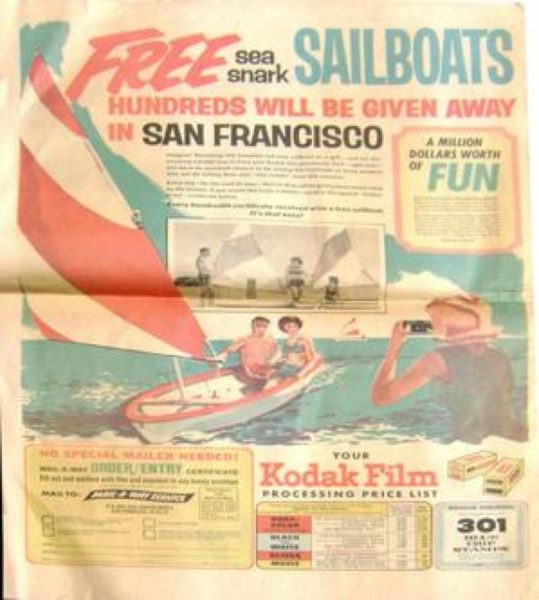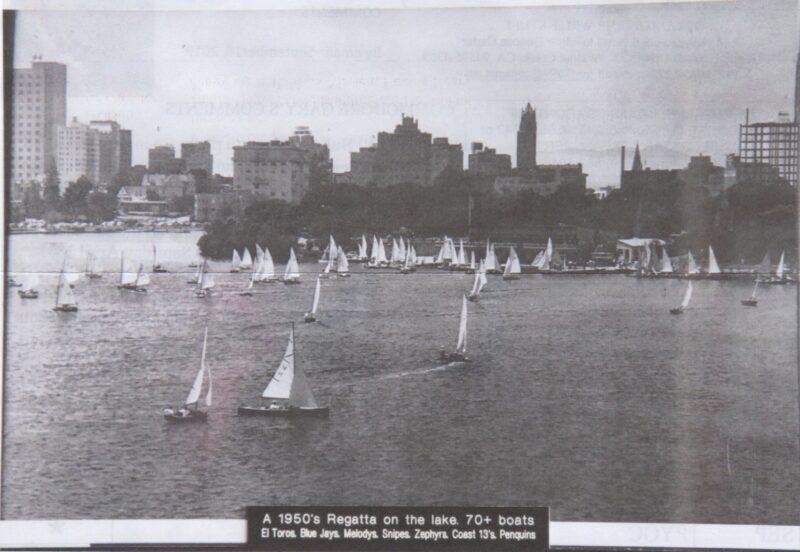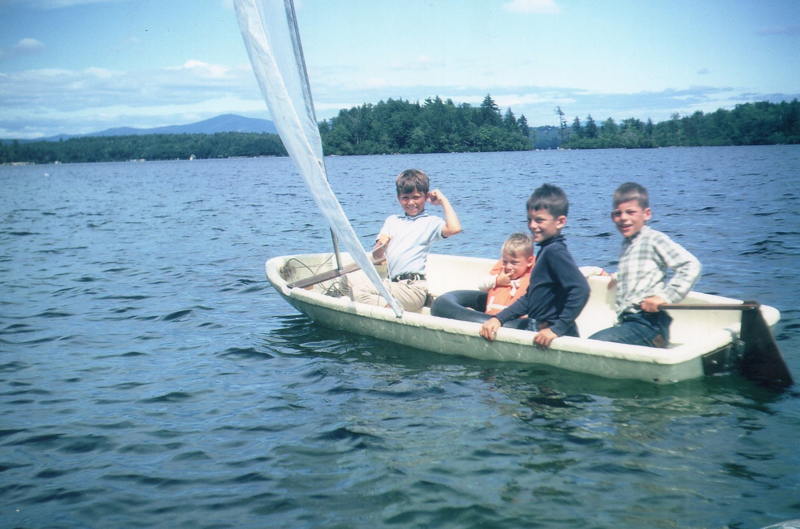
Free Sailboats Are the Secret to Growing Sailing
American Magic, the US challenger for the 36th and 37th America’s Cup, and Nautor Swan recently announced a partnership aimed at energizing sailing in America. We’re skeptical. We’re reminded that the peak growth of participation in sailing was in the ’60s and ’70s. Building with fiberglass was hitting its stride, and people had real, two-day weekends when they didn’t look at emails and devices. They went outdoors and played. Sailboats were small, affordable, and even free! We discovered this when looking up information on our family’s first boat — a Styrofoam Snark. We found the following ad from a 1960s edition of the San Francisco Chronicle.

We know a Styrofoam Snark would be lucky to last five minutes on the Cityfront before it became flotsam drifting up onto the Emeryville shoreline, but if you took it to Lake Merritt with your family, the kids could have a blast. And you could take photos of them to show your friends, with your Kodak film camera. When you showed your friends the photographs you became an “influencer” and more people wanted to sail. Small, affordable boats made sailing boom. California was at the epicenter of that boom, with Costa Mesa builders flooding the world with small, affordable fiberglass sailboats.

Lake Merritt in Oakland was a hotbed of small-boat sailing. You can still rent sailboats there for $15/hr.
Believe it or not, there are lots of “Free” sailboats available, such as the Coronado 25 John Super is offering in our Classy Classifieds. And a Coronado 25 is the same boat world-famous yacht designer Ron Holland owns in Victoria, British Columbia.
A reminder that Economics 101 taught us all “TANSTAAFL,” which stands for “There Ain’t No Such Thing As a Free Lunch.” It would be irresponsible for us not to mention that as soon as you own it the expenses will begin — insurance, slip fees, maintenance, etc., but boats like the Coronado 25 started millions of people off on a lifetime of sailing adventures. You can spend $5,000 on a bicycle that seats one, or partner on a Coronado 25 that seats and sleeps four or more!
Free Snarks also launched thousands of sailors. Our family’s first boat was a Snark, though it cost about $120. The first bright-yellow plastic sail ripped, so our mother sewed a new one out of clear plastic. The Snark, plus a Turnabout, a Rhodes 19, a 420, and a Laser were the small boats that started us off on a lifetime of sailing.

We were thrilled to learn that American Magic and Nautor Swan are partnering to re-energize sailing in America; that they’re focusing on growing sailing. However, their initial focus is to promote Swan’s new ClubSwan 28 regatta series. To join this you need to purchase a new ClubSwan 28 for about $250,000. It sounds like an awesome boat and would be a ton of fun to race in the class, but will it really re-energize sailing in the US? Can you grow participation in sailing by selling quarter-million-dollar boats? We never say never, so we support anyone who’s on the mission to grow participation, but we think sailing would grow faster with Snarks, El Toros, Rhodes 19s and Catalina 22s. At least that’s what worked in the past.
“This joint venture marks a significant step in American Magic’s mission to lead sailing in the United States into a new era of innovation and competition,” said Terry Hutchinson, president of sailing operations at American Magic.
We wonder if most sailors are looking to spend their weekends involved in “a new era of innovation and competition,” or if they just want to relax and go sailing with their family and friends.

One of the most successful sailing clubs on the Bay is the Richmond Yacht Club because of their emphasis on small boats and youth sailing. Small boats allow you to fit more sailors and sailboats within the confines of limited space on a shoreline. We love big boats and our big Sabre 38 sloop, but when we see sailing growing, we see it happening when small-boat sailing is reenergized. Just as we don’t think the homeless problem is going to be solved by building McMansions, we don’t see growth in sailing being driven by high-tech boats costing hundreds of thousands of dollars. Maybe that’s just us.
There are all kinds of sailors, and that’s why there are all kinds of boats. We’re agnostic regarding what people choose to sail. Fantastic, fast foiling boards are awesome, but so is singlehanding your Westsail 32 in the Three Bridge Fiasco. Larry Ellison started on a Lido 14 at the Cal Sailing Club before moving up to a Perini Navi megayacht (and a few other boats). We wish Nautor Swan and American Magic good luck with their efforts to reenergize sailing, but to help sailing do some market research, we’re curious: How would you reenergize sailing?
You can find inexpensive boats in our Classy Classifieds or great youth sailing programs in our Youth Programs page. Think big, but start small.

Totally agree it needs to be small and cheap. But I also think it is more about access and storage costs than the type of vessel. Small car-top boats make more sense but storing them is still a hurdle. Seems like the kind of folks who would have gone for a Laser or Hobie Cat back in the 1970s are now getting into wing foiling (which fits in the back of a Mini Cooper) or going out on a paddle board. And those who want a slightly drier and safer experience are put off by the cost and hassle of getting on the water in a real boat.
Not sure we will ever see reenergized boating as is was in the 60’s, 70’s and 80’s.
When we bought our first boat as teenagers, dad said “pay cash and if you need to ask how
much, do not buy it”. That was in the late 60’s. The changes we have seen in boating over the years,
started when people started buying boats with monthly payments. Yes smaller boats are the way
to start, if you can pay cash and have a vehicle to move them. Yes there is no free boat, Insurance, repairs, storage costs, transportation…. My suggestion is find boating clubs,
that cater to those who want to go boating, but do not have the disposable income to own one.
If you walk around the bay area marines, it is sad to see the percent of boats that leave the docks
rarely if at all. They may all look nice, but many get little or no use. As we see the changes in
“middle class”, so will we see more changes in boating.
Since you asked……The first step to spark interest is inviting a non boater to go boating and asking them to bring along their kids.
Great article! The Kodak “free boats” promotion, (“A million dollars worth of fun”) is so cool. Family smallboat sailing, bringing along friends, unplugging for an afternoon, is a lifestyle that should never go out of style. But we need to promote it more!
Sprint 750s are the answer
A Snark was great! Stored mine in the apartment master bedroom, hanging from the ceiling! Cannot do that with the present boat, The snark could be carried to car, roof topped the driven to a lake upon a late summer afternoon whim.
I have a theory that mooring fields would make boating more affordable for a greater number of people -slip fees are quite expensive. There are many 1980’s 25 to 40 foot boats that would make big boating affordable for more people – at relatively low up front investment. We’ve had several 20-something couples approach us when we’re in port on our 1982 Islander P40 and say it is their dream to learn sailing and cruise. That generation’s concern for the environment and focus on experiences makes sailing attractive to them. Comparing sailing to power boating to one couple, I said that “with sailing it’s more about the journey and not just getting there,” and the woman lit up and replied “that’s exactly how we want to live our lives.” There’s good potential with that generation. We just need to find ways to minimize recurring costs.
Joe Kirk
Point of Pittsburgh Sailing League
I think both the type of boat and accessibility are crucial to growing the sport. The answer for our Pittsburgh Sailing program was to secure grant funds which permitted us to purchase RS Quests. We then have a no-turn-away policy based on ability to pay. Having a more recent model of boat with both safety and performance features, helps us to maintain the interest of sailors as they build sailing skills. We also have a city-based location with transit service.
When buying your first small boat buy two promote competition bring a friend Sabots would be the best first option most competitive and largest class racing
The E-Scow, a four-person one-design monohull popular on lakes in the USA, now costs over $100K under the monopoly of Melges Boatworks.
The sailing industry in the USA is uncreative and is cannibalizing itself.
I bought my sea snark for $10, 7 years ago I wrapped it in fresh epoxy fiberglass and bought a new sail
I just got it sail ready for the season l hope to use it again this summer. it’s a great little boat that I can take anywhere in the back of my truck.
Here in Texas it costs me $0 to keep it. besides occasional repairs.
Sailing is my life’s passion from 1957 at 4 yrs old in a home made wood planked sinker to today, 2025, in a 40 ft salvaged Bounty II.
Mesmerized and involved is how many children become when out for a sail or a longer distance over night jaunt. However, there are those who just could not put down their smart phone (like their parents) and never got involved and never gained interest.
Reaching the physical age where annual maintenance and sailing endeavours are becoming daunting, I hope there will be a young adult stricken with sailing fever who will take over. LISound, CT
When my husband and I started dating, we, of course, compared our sailing histories. We had two things in common from our early sailing days: our dads had flown us to Bermuda in 1980 to do the deliveries home with them, and they’d bought us Snarks to knock about in. At that point almost opposite ends of the sailing spectrum. Which hooked us? The Snark or the big boat delivery? Probably neither or maybe both.
More likely, it was someone introducing us to the awesomeness of sailing! Take a friend or family member sailing on whatever you can. Make sailing accessible any way we can. That’s how we make sailors.
Great ideas as always from this group. New boats of any kind are not the “answer” however. They are simply too expensive. Collecting free boats like the Coronado 25 you mentioned and putting them into a sailing club with memberships to share the ownership is the answer. That may not be the boat but there are boats for every area. Supporting community boating programs like those here on the east coast in Providence, New Bedford, and Boston, are fantastic and for small money you can join and have great boats that are generally well maintained to sail anytime.
There are a ton of free boats available, we just need to be able to find them, destroy the bad ones, maintain the good ones and move on. Once people of lesser means get into sailing/boating they’ll be more inclined to move up into new boats. For the wealthy among us, please do support the industry and buy new if it’s easily affordable to you. Lastly, someone mentioned bringing friends and their families sailing. That is fantastic!
My entry into sailing involved a number of near free boats that needed lots of work. Sailing is EXPENSIVE if you’re not handy. And an ability to scrounge used parts or fabricate parts out of stainless or aluminum is vital
I think the ever increasing cost of admission is what keeps people away from any type of boating. And I also agree about the disappointingly high number of boats that never leave the slip except it the fall when it’s time to winterise. I’m a south shore Long Island boating veteran of both sail and power who finally got out of boating because of the people we saw it was attracting. Admittedly by then we were all in with a 36’ double cabin Mainship and most of the boats around us were power due to the relatively shallow waters of the Great South Bay, but the element of boaters were were encountering had slipped considerably. While I can’t broad brush the sailing community I think that a similar element may have been intruding there as well. We ultimately sold our boat and got out of boating all together and retired to the Berkshires where there are only small lakes to piddle around in. While we could get back in, we have moved on and except for an occasional rental are completely done with boating.
Sailing is a time-consuming hobby. Expense can be managed by starting small and used, but a sail works pretty much the same on cheaper boats as it does on expensive ones. A huge active fleet that is still current is the Catalina 22 that can be dry stored, trailer launched, sleeps 4+, and even be raced in one-design regattas. I never plan to sell my Sunfish. Hobie 16 fleets are growing as new boats are being made again adding to the ton of used boats needing a home. Anyone on a tight budget can start with classes already mentioned as well as these if they have the time. It takes discipline to put the iPhone down and grab a tiller. Invite a friend and pack a cooler. There may be a lot of people who are ready to enjoy a change of life style to spend it outdoors in a refreshing breeze doing something much more satisfying than staring at a computer screen. Keep asking new folks to join you, and the sport will grow.
There can be only one…….Highlander !! Kinda partial to this Douglas/McCloud One Design because she was my first (hull # 871). Highlander Class International Association. Sailhighlander.org. Check em’ out.
Sailing is a gift. A lifetime of learning you can share with everyone. One never knows everything. It initially scares us enough so we pay attention. Then when you steer the boat it magically moves with the most gentle motion with fingertips on the helm. Then on bigger boats you’re moving more quickly than you imagine. The peaceful motion, camaraderie, the team the boat builds excites everyone who gets to go. So give someone the gift. Take them sailing.
This whole thread brings back such great memories over a lifetime of sailing. I started sailing on a 14 foot fiberglass daysailer my dad bought for $700. Our current boat is our third Santana 22 which we own in partnership with our neighbor. We split all the costs. In spring, summer and fall, we are sailing at least once a week. Our current Santana 22 is going to have its 50th birthday this year. We bought it for $2,500 three years ago. We added a few nice features such as a roller furling jib and an electric outboard, but even now our total investment is way under $10,000. When we see new boats in our size range going for as much as $75,000 we wonder how somebody can have ten times the fun on a newer, cooler, slightly faster boat. For us old geezers, our Santana is a perfect vessel for low cost fun on the water.
Alan–Sausalito, CA
I learned to sail on my dad’s built from a kit Sailfish on Peconic Bay and, sadly, haven’t sailed much since my teenage years. I’ll return to sailing this summer, following in my dad’s footsteps by building my own nesting 12′ Mebo from plans. It fits in my 8’x12′ shed and will cartop on my VW Golf. My hope is to share the joy with my married children and grandchildren.
I won a Snark sailboat at Hamptons “Bay Days” celebration back in 1976 and never looked back. I’ve been sailing ever since…of course with a few sailboat upgrades… I also had just finished reading “The Dove” Robin Graham’s coming of age sailing epic. Yep, that did me in…been “addicted” to the sea ever since!
I grew up sailing on Snarks. I could cartop one on our VW bug and head out to the lake (in Vermont) for a day by myself. When I lived in Decatur, IL for a year or so, they had a very nice yacht club where I could take a Lazer sailboat out during the week – I think it was only $60/year membership. It’s now $100/year for an Associate membership. That’s an awesome way to get people sailing – https://saildecatur.org/. Now I’m trying to find a used Snark on the West Coast – because I think I could still lift it onto a car.